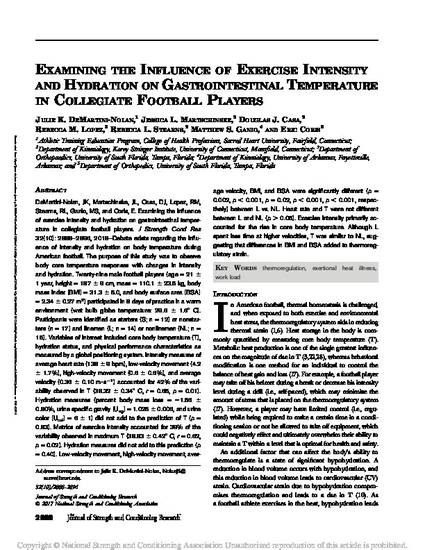
Debate exists regarding the influence of intensity and hydration on body temperature during American football. The purpose of this study was to observe body core temperature responses with changes in intensity and hydration. Twenty-nine male football players (age = 21 ± 1 year, height = 187 ± 9 cm, mass = 110.1 ± 23.5 kg, body mass index [BMI] = 31.3 ± 5.0, and body surface area [BSA] = 2.34 ± 0.27 m2) participated in 8 days of practice in a warm environment (wet bulb globe temperature: 29.6 ± 1.6° C). Participants were identified as starters (S; n = 12) or nonstarters (n = 17) and linemen (L; n = 14) or nonlinemen (NL; n = 15). Variables of interest included core body temperature (T), hydration status, and physical performance characteristics as measured by a global positioning system. Intensity measures of average heart rate (138 ± 9 bpm), low-velocity movement (4.2 ± 1.7%), high-velocity movement (0.6 ± 0.6%), and average velocity (0.36 ± 0.10 m·s−1) accounted for 42% of the variability observed in T (38.32 ± 0.34° C, r = 0.65, p = 0.01). Hydration measures (percent body mass loss = −1.56 ± 0.80%, urine specific gravity [Usg] = 1.025 ± 0.006, and urine color [Ucol] = 6 ± 1) did not add to the prediction of T (p = 0.83). Metrics of exercise intensity accounted for 39% of the variability observed in maximum T (38.83 ± 0.42° C, r = 0.62, p = 0.02). Hydration measures did not add to this prediction (p = 0.40). Low-velocity movement, high-velocity movement, average velocity, BMI, and BSA were significantly different (p = 0.002, p < 0.001, p = 0.02, p < 0.001, p < 0.001, respectively) between L vs. NL. Heart rate and T were not different between L and NL (p > 0.05). Exercise intensity primarily accounted for the rise in core body temperature. Although L spent less time at higher velocities, T was similar to NL, suggesting that differences in BMI and BSA added to thermoregulatory strain.
DeMartini-Nolan, J. K., Martschinske, J. L., Casa, D. J., Lopez, R. M., Stearns, R. L., Ganio, M. S., & Coris, E. (2018). Examining the influence of exercise intensity and hydration on gastrointestinal temperature in collegiate football players. The Journal of Strength & Conditioning Research, 32(10), 2888-2896. Doi: 10.1519/JSC.0000000000002137
